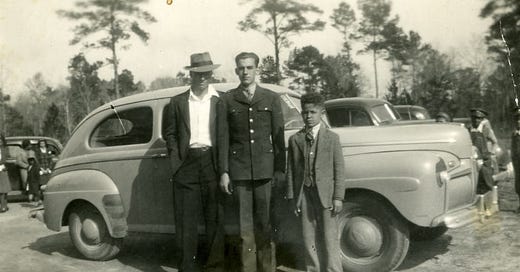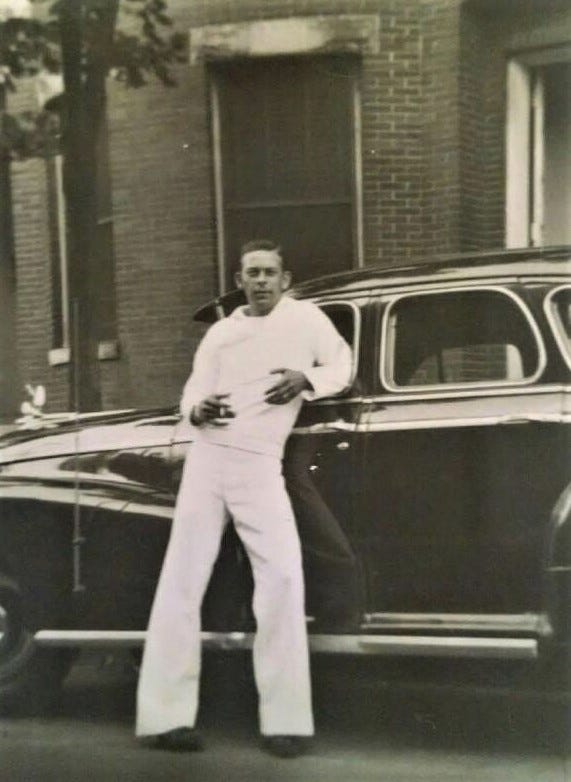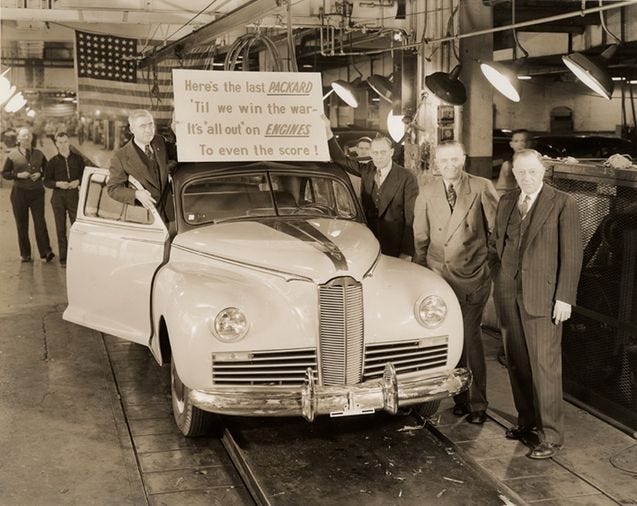“Yesterday, December 7th, 1941 — a date which will live in infamy — the United States of America was suddenly and deliberately attacked by naval and air forces of the Empire of Japan… No matter how long it may take us to overcome this premeditated invasion, the American people in their righteous might will win through to absolute victory.”
— President Franklin D. Roosevelt at the emergency joint session of Congress, December 8, 1941
And with that, passenger car production in the United States would soon cease, and the industrial might of America’s car companies would be retooled as the Arsenal of Democracy.
As is still the custom, car dealers in December 1941 had been selling their new 1942 lines since early September. Sales were somewhat moribund, perhaps because the public was well aware of the new war already raging around the globe and was anticipating America’s eventual involvement. There were some notable styling changes that appeared in 1942, like the disappearance of running boards and the extended torpedo fenders on GM cars, but underneath the change from 1941 models was minimal. Maybe for the same reason.
In any case, the attack on Pearl Harbor 80 years ago today essentially ended civilian car production in the US for nearly four years. On January 1, 1942 new car sales were strictly rationed, by law, while production briefly continued to fill existing sales backlogs. On February 12 the last 1942 civilian production car rolled off American assembly lines, which would be fully dedicated to the war effort.
In total fewer than one million 1942 model year cars were sold in the US, the lowest industry output since 1915. They are a rarity, and it always piques my interest when I spot a ‘42 at a car show or in a car ID request. And it’s not always that easy to solidly ID one, unless the photo has a clear shot of the grille and trim. Once the war ended in 1945 Detroit resumed selling near-clones of the 1942 models for a few more years while they retooled for the modern postwar boom. That’s why you’ll often see me IDing a car as a “1942 or 1946-48” model year.
But what you’ll see in the following case photos are definitely ‘42s, and the folks in them often illustrate the grim determination of Americans following Pearl Harbor. An excellent example is this photo from @AstonishingFMan, with a young man looking fresh from military training. The people here are unidentified, but I suspect the man on left is his father and the young gent a cousin or family friend. One wonders if the soldier was an early enlistee after the attack, and if the 1942 Ford Tudor behind them has a war gas ration sticker on its windshield.
The last production 1942 Ford came off the line on February 10, and the company began producing all manner of equipment for the war effort — most notably B-24 bombers at its Willow Run plant, and GPW Jeeps. Ford’s GPW Jeeps were slightly less numerous than Willys MB Jeeps, but they were essentially identical except for the embossed manufacture logo on the rear panel. Ford also made trucks, tow vehicles, amphibious GPAs, missiles, and engines for M-4 and M-10 tank destroyers for the duration. The shot below shows B-24s being assembled at Ford’s Willow Run plant in 1942. The depicted ‘42 Ford may have been built there less than a year earlier.
The determined young flyboy in this photo is the grandfather of Andrew Feldorenzo, sitting behind the wheel of a 1942 Pontiac convertible in Sarasota, Florida. I suspect at Sarasota Army Air Base, a busy site in 1942-45 for training bomber crews as well as fighter pilots. At the bottom of the photo you see how the torpedo fenders extend into the door, a new Harley Earl styling feature that first appeared across all GM brands in the 1942 model year.
The last 1942 Pontiac came off the line on February 2. During the war, GM’s Pontiac division didn’t get the glamor tank and bomber production assignments of some of their sister brands and competitors, but they contributed to victory by producing 20mm and 40mm anti-aircraft guns and cannons as well as torpedoes for warships and naval torpedo bombers. I’ve got to think more than a few Imperial Japanese ships and planes were put out of commission by those products. Pontiac also produced components like engine blocks and drive axles for GM’s tank and military truck production.
It wasn’t just men serving in uniform at the time. This smiling WAC (Women’s Army Corps) is Catherine Schuyler’s grandmother, who is about to get into a very snappy 1942 Buick Roadmaster convertible. The WACs were first established as the WAACs (Women’s Auxiliary Army Corps) only a few months after Pearl Harbor, as all hands — both men and women — were needed on deck. My beloved great aunt Fran likewise served as a WW2 WAC. I pointed out the extend-into-door pontoon fenders on the Pontiac in the previous photo, which were also a new feature of Buicks in 1942. But only the top-of-the-line Roadmaster had them extend all the way through to the rear quarter panel, as you can see here. This would be just about the most advanced styling you would see on any prewar American production car.
The last 1942 Buick civilian car, another Roadmaster, rolled off the Flint assembly line on February 3, an event commemorated in the photo below. For the duration of the war the Buick plant was retooled for the production of war materiel, most notably aircraft engines. Buick was the main producer of cylinder heads for massive Pratt & Whitney radial engines, many of which eventually found their way to the B-24 bombers made at Ford. Those engines were also used in Douglas C-47 Skytrains for troop transport and to airdrop paratroopers. Buick also made M-18 Hellcat tank destroyers, and engine components for amphibious landing craft. I suspect the workers in this photo were in the thick of that production.
GM cars weren’t alone in getting a fender styling update in ‘42. The dauntless sailor here, a family friend of “Duck Hunter TX,” is leaning against a 1942 Packard Clipper sedan. The Clipper’s integrated fender design was a somewhat daring departure from the rest of the 1942 Packard line, which retained their conservative 1930s style fender separation. But the real star here is the young swabbie, looking ready to take the fight to Tojo and avenge Pearl Harbor.
You can get a better gander at those Clipper fenders in this Packard publicity shot, showing the last prewar production Packard car coming off the assembly line on February 9, 1942. Note the “It’s ‘all out on ENGINES” line on the placard.
Indeed, Packard went all out making engines, famously the Merlin V-12 made under license from Rolls-Royce. Those mighty Merlins were used to power the RAF’s legendary Spitfire fighter planes, and the Packard version was used in the equally legendary P-51 Mustang fighters of the US Army Air Corps. Those Packard Merlins were also used in Canadian De Havilland Mosquitoes and British Lancaster bombers. Packard also build another legendary V-12 marine engine, the 4M2500, used in Higgins and Elco PT boats.
Circling back to GM, in this photo from Joseph Spiegel we see his older brother in 1944 romping in front of the family’s 1942 Oldsmobile Dynamic coupe. A good illustration of the ‘42 model year reset: the disappearance of running boards, Harley Earl’s extended door fenders, the sloping fastback. Olds called its fastback body style the “Dynamic,” Buick and Cadillac called it the “Sedanette,” Pontiac called it the “Torpedo” or “Streamliner,” Chevy would call it the “Fleetline.” This would be the apotheosis of GM styling up until 1949. And the photo also provides a good illustration of what all those soldiers, sailors, airmen, and Marines were fighting for: peace, freedom, and a new generation happily playing in the yard.
No further 1942 Oldsmobiles would be made after February 5. For the next few years the Olds plant in Lansing, Michigan was all about cannons — 125,000 of them — along with millions of artillery shells. Those Oldsmobile-made cannons constituted the business end of thousand of US tanks like the M4, M10, and M18, and also found their way into ground and naval anti-aircraft applications, and the nose cannons of US fighters and bombers. Oldsmobile also produced axles for heavy military trucks and castings for aircraft landing gear, and their durable Hydromatic automatic transmissions were used in tanks to cut valuable training time for tank drivers.
The unidentified man in this photo from @fobrg is posing for a snowy photo op in front of a 1942 Nash Ambassador convertible, probably the rarest of the ‘42s seen in this issue. Like Ford, the ‘42 Nash featured minimal cosmetic changes to the ‘41, and would remain almost identical through 1948. It’s somewhat noteworthy that Nash at the time fell into the conservative, “normal” part of the car design spectrum. In 1949 they would throw that template out the window, creating some of the weirdest and wackiest postwar car designs that, whatever you thought of them, set Nash apart from the crowd.
Nash marked its final 1942 production car with the photo below, dated February 4. During the war Nash-Kelvinator would have an aircraft focus, building over 18,000 Pratt & Whitney R-2800 radial engines. Those were the power plants of Grumman F6F Hellcats and Vaught F4U Corsairs, the #1 and #2 leading fighter planes in taking out Japanese aircraft in WW2. They also build propellors, Jeep trailers, rocket motors for naval artillery, and oddly enough, over 200,000 pairs of binoculars. The most surprising thing is that Nash was the largest builder of Sikorsky helicopters in WW2. One doesn’t generally associate WW2 with helicopters, but the US military did have a few hundred of them which were mostly made at the Nash plant in Kenosha, Wisconsin.
I will finish off the 1942 model illustration with this swell 1943 photo from C. Stewart Wright III showing his dad (I presume C. Stewart Wright II) and a buddy during their training days at Ball State U. in Muncie, Indiana, prior to shipping out to Europe. The star-wearing staff car behind them is a bit of a chimera; it is a “Plodge” — essentially a 1942 Plymouth with 1942 Canadian Dodge trim. This car was made at Dodge’s Canadian plant in the latter days of 1941, as part of the Lend-Lease Act. Prior to Pearl Harbor, America was still walking a tightrope of isolationism as Europe descended into war. Concerned that directly donating military goods to Great Britain would provoke a German declaration of war against the US, Roosevelt proposed the Lend-Lease Act — “lending” US supplies to Great Britain on a delayed payment plan — as a fig leaf. Canadian manufacture of those goods added another layer to the fig leaf. It’s likely this staff car was initially slated for shipment to the British military, but after Pearl Harbor ended up enlisted, like these boys, into the US Army.
I would be negligent not to mention the many contribution of the Chrysler Corporation to America’s efforts in WW2, most famously the heavy duty 4- and 6-wheel drive Dodge WC Power Wagons that slogged through the mud of Europe during the race to Berlin. But Chrysler also built over 25,000 tanks, including the M3 Grant and the M4 Sherman, and huge 18-cylinder Wright Cyclone radial aircraft engines. Seven out of the 8 Cyclone engines on the Enola Gay and the Bockscar, the two B-29s whose nuclear payload ended the conflict with Japan, were built by Chrysler.
While I don’t as yet have specific ID cases involving their 1942 car models, I would also be remiss not to mention the WW2 contributions of other GM divisions like Chevrolet and GMC who built countless trucks, ambulances, aircraft engines, and amphibious “Duck” boats; or Cadillac, whose modified flathead V8 passenger car engines were used to power M5 and M24 tanks. Not to mention Hudson and their Invader engines that powered most of the D-Day landing craft, and Studebaker’s “Deuce and a Half” Hercules trucks and all-terrain “Weasels.” Even America’s smallest remaining car companies — Checker, Graham-Paige, Crosley, and American Bantam — got into the act, along with nearly all commercial truck makers. And of course there were the military motorcycles of Harley-Davidson and Indian, and the Airborne motor scooters provided by Cushman.
So next time you run across a 1942 model at a car show or museum, doff your cap to the men and women of America’s WW2 auto industry. Their ingenuity, productivity, and near-overnight transformation into the Arsenal of Democracy made sure that America’s entry into war 80 years ago today would be over less than four year later.
V for Victory, Keep ‘Em Flying, and Happy Motoring,
Dave















Great stuff Dave. Amazing how our country came together. My Dad, Iowa farm kid, was the head mechanic on the Santee in the Pacific. There was nothing he could not fix with pliers and some bailing wire. Never talked about the war til later in life when his ship mates starting having ship reunions. Truly, the greatest generation.
I believe the handful of cars produced in calendar year 1942 had "blackout trim" - aka, no more chrome.
Nash and the other independent car companies really let their freak flags fly in the postwar period. It wasn't until 1949 when one of the Big Three (Ford) came out with a really new design. Sadly, by the early fifties the "step-down" Hudson and the "forwards or backwards?" Studebaker were passe.